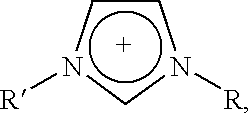Mixtures of ionic liquids with lewis acids
a technology of ionic liquid and lewis acid, which is applied in the direction of physical/chemical process catalysts, organic-compound/hydride/coordination complex catalysts, and separation processes, etc. it can solve the problem of forming free acid of anion, the molar percentage of alclsub>3 /sub>cannot be increased beyond, and the use of lewis acid at very low levels relative to the rest of the ionic acid
- Summary
- Abstract
- Description
- Claims
- Application Information
AI Technical Summary
Benefits of technology
Problems solved by technology
Method used
Image
Examples
example 2
1-Ethyl-4-methylpyridinium([4-MEP]) bis(trifluoromethylsulfonyl)imide / aluminum(III)chloride ([4-MEP][(CF3SO2)2N] / AlCl3) mixtures:
[0110] A. 1:1 mixture
[0111] At 90° C., while stirring add 11.7 mmol AlCl3 to 11.7 mmol ([4-MEP][(CF3SO2)2N]). A two-phase system forms in which both phases have roughly the same volume. Upon cooling, the AlCl3 precipitates out of this system at temperatures below 70° C.
[0112] B. 1:2 mixture
[0113] At 70° C. while stirring add 23.2 mmol AlCl3 to 11.7 mmol ([4-MEP][(CF3SO2)2N]). A 2-phase mixture forms with the volume of the lower phase substantially smaller than that of the upper phase. No solid precipitates from this system even upon cooling to room temperature.
[0114] C. 1:3 mixture
[0115] At 105° C. while stirring add 34.3 mmol AlCl3 to 11.7 mmol ([4-MEP][(CF3SO2)2N]). A clear phase is formed, which, after cooling to room temperature remains single-phased and clear.
[0116] D. 1:4 mixture
[0117] At 130° C. while stirring add 46.6 mmol AlCl3 to 11.7 mm...
example 3
Reaction of octanoic acid chloride with 1-chloro-2-phenylethane with the ionic liquid ([3-MEP][(CF3SO2)2N] / AlCl3) (molar ratio 1:3) as the catalytically active component
[0118] Under inert gas atmosphere while stirring at 105° C. 40 mmol AlCl3 is slowly added to 13.3 mmol ([3-MEP][(CF3SO2)2N]). A clear, homogeneous single-phase solution forms and remains clear and single-phase after cooling to room temperature. The resulting ionic liquid is mixed at room temperature 20 mmol octanoic acid chloride. 20 mmol 1-chloro-2-phenylethane is mixed in dropwise at room temperature. The reaction mixture is stirred for 6 hours at room temperature. The reaction mixture is carefully hydrolyzed with an excess amount of water; the aqueous phase extracted with CH2Cl2. CH2Cl2 is removed under a light vacuum, and the residue extracted with pentane. While the educts and products of the reaction dissolve in pentane, 11 mmol of the ionic liquid ([3-MEP][(CF3SO2)2N]) is recovered as residue. Based on GC an...
PUM
| Property | Measurement | Unit |
|---|---|---|
| Temperature | aaaaa | aaaaa |
| Temperature | aaaaa | aaaaa |
| Temperature | aaaaa | aaaaa |
Abstract
Description
Claims
Application Information
 Login to View More
Login to View More - R&D
- Intellectual Property
- Life Sciences
- Materials
- Tech Scout
- Unparalleled Data Quality
- Higher Quality Content
- 60% Fewer Hallucinations
Browse by: Latest US Patents, China's latest patents, Technical Efficacy Thesaurus, Application Domain, Technology Topic, Popular Technical Reports.
© 2025 PatSnap. All rights reserved.Legal|Privacy policy|Modern Slavery Act Transparency Statement|Sitemap|About US| Contact US: help@patsnap.com


